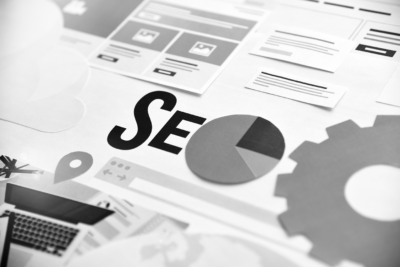AI Mode in the USA – a revolution in search and digital marketing
The introduction of Google AI Mode in the U.S. is affecting user behavior and their purchasing journey in e-commerce. Here are the initial insights and what Martin Splitt highlighted during Google Search Central Live 2025 in Warsaw.
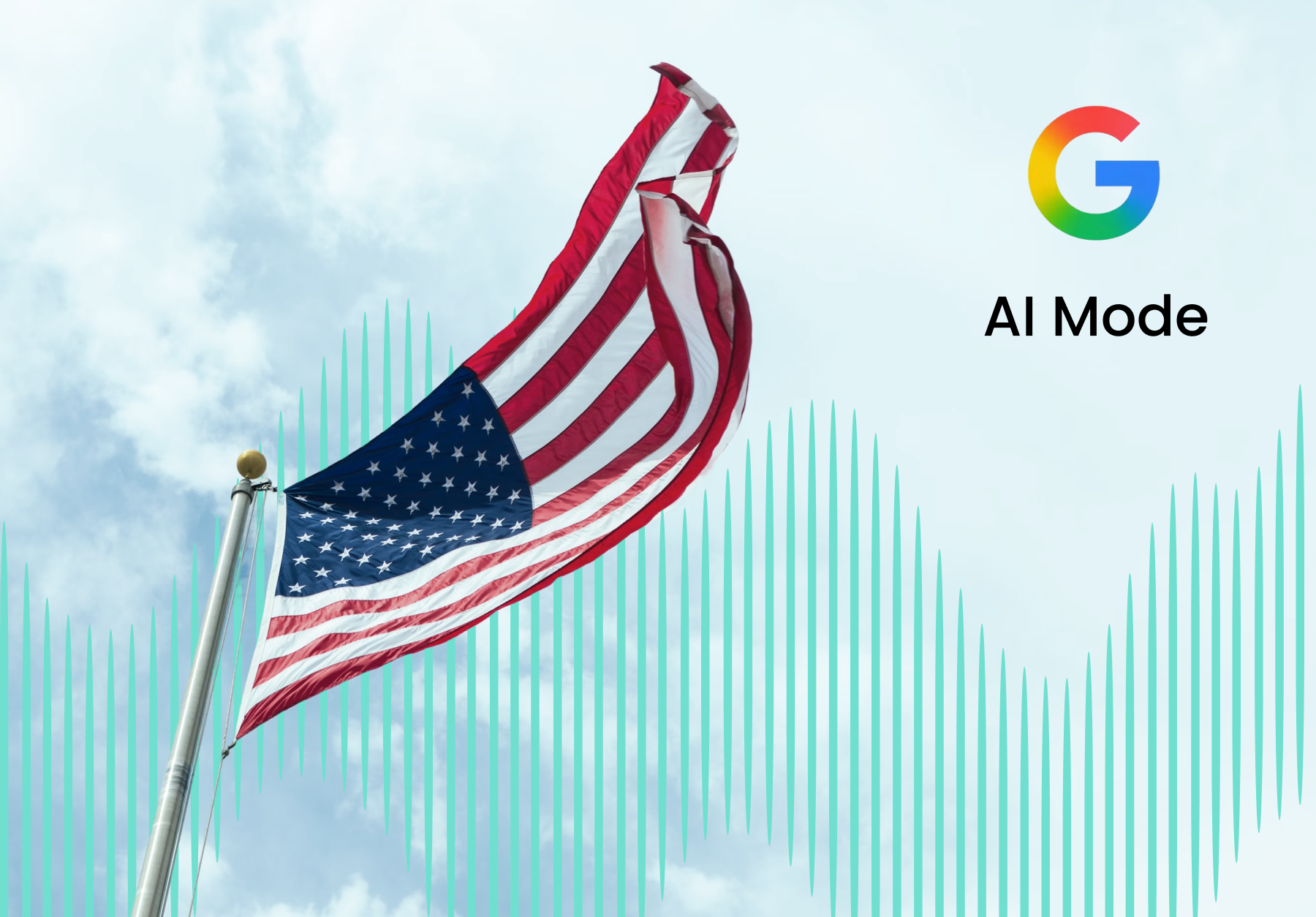
In the United States, Google has launched AI Mode – an advanced search mode that leverages state-of-the-art language models (including Gemini 2.5) to generate answers to complex, multi-part questions. In this article, I’ll analyze how AI Mode and AI Overviews are reshaping the market, user behavior, SEO and marketing strategies, and I’ll share practical recommendations and real-world examples of AI transforming not just technology but also the daily habits of internet users.
The scale and significance of AI in the U.S.
AI’s dominance in chatbots and search
In the U.S., the AI chatbot market is dominated by ChatGPT (78.46% share), Perplexity (16.09%), and Google Gemini (3.57%). The chatbot market is growing rapidly – it’s projected to reach $10.5 million by 2033, with an annual growth rate of 22%. Meanwhile, Google – still the leader in search engines with a 91% market share – has been losing ground to AI; its share recently dropped by 3%.
User reluctance to AI Overview
The introduction of Google AI Overview in the U.S. has sparked widespread discussion about its impact on organic traffic. Early data and case studies published by SEO specialists on platforms such as Twitter (X), LinkedIn, and industry blogs (e.g., Search Engine Land, Moz Blog, Search Engine Journal) indicate a drop in CTR (click-through rate) for traditional organic results in queries where AI Overview appears. Although exact average figures are difficult to determine due to the variety of queries and industries, unofficial reports suggest CTR drops of around 10–30% for certain types of queries.
It’s also worth noting that users in the U.S. are increasingly choosing to disable the AI Overview feature in search engines, even though its popularity continues to grow.
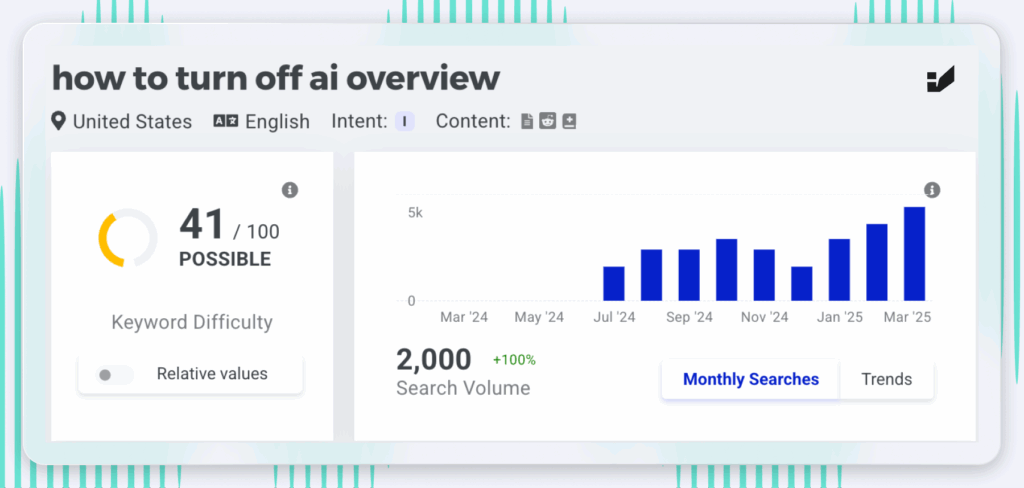
To compare, there’s lack of interest in how to disable the AI Overview in Poland:
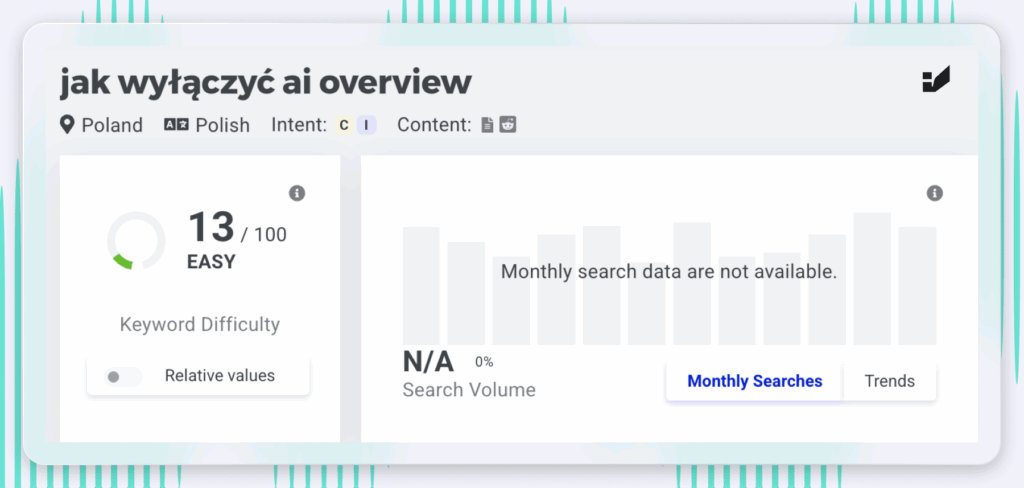
This trend may point to a need for more precise and personalized search results.
On the other hand, the growing interest in AI in the U.S. is a positive signal for companies looking to leverage these technologies to boost their visibility and marketing effectiveness.
Get free AI Search Visibility checklist
How’s your brand’s visibility in AI Search? Assess & optimize it with an actionable checklist.
AI Overviews and AI Mode – a new standard in search
AI Overviews are AI-generated summaries of answers that appear directly within Google’s search results. According to Semrush data, by March 2025, 13.14% of all search queries in the U.S. triggered AI Overviews – up from 6.49% in January of the same year. These summaries most often appear for informational queries (88.1%) and in sectors like science, health, society, and law.
AI Mode represents the next step in search evolution – users can ask questions in natural language, receive conversational-style answers, and continue the dialogue with follow-up questions. This mode is available in a dedicated Google tab and utilizes the latest generative model capabilities, such as breaking down complex queries into subtopics and analyzing multiple sources simultaneously.

Impact analysis in examples
Example 1: Decline in organic traffic
The launch of AI Overviews in the U.S. has caused a noticeable drop in organic website traffic. On average, click-through rates (CTR) decreased by 8.45%, and for top-ranked results, the decline was as high as 10.4%. Some sites experienced traffic drops of 20–60%, especially in industries where AI Overviews appear most often. Users are receiving answers directly in the search results, leading to “zero-click searches” – in 2024, 58.5% of U.S. searches ended without a click to an external site.
Example 2: Changing user behavior
AI Mode and AI Overviews are making users less likely to click on traditional search results. Instead, they rely on AI-generated answers, which often include summaries, product recommendations, and excerpts from multiple sources.
Example: A user types:
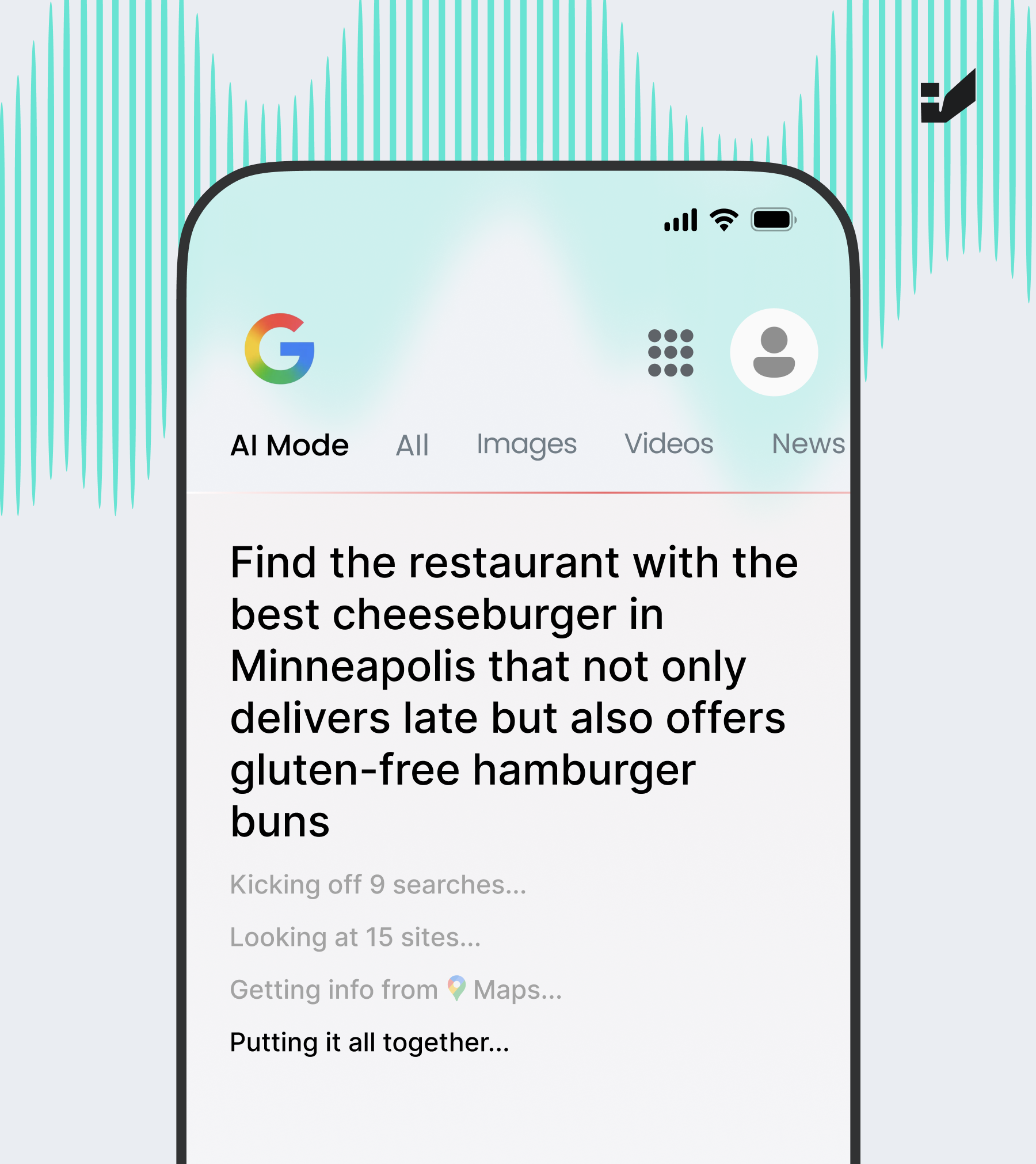
and receives a list of recommendations with short descriptions – no need to visit individual websites.
Example 3: Impact on e-commerce
Google is aggressively integrating product boxes into both traditional search results and AI Overviews. Online stores that optimize their listings in Google Merchant Center and use structured data have a higher chance of being featured as recommended sources in AI Overviews.
Example: A user asks for:
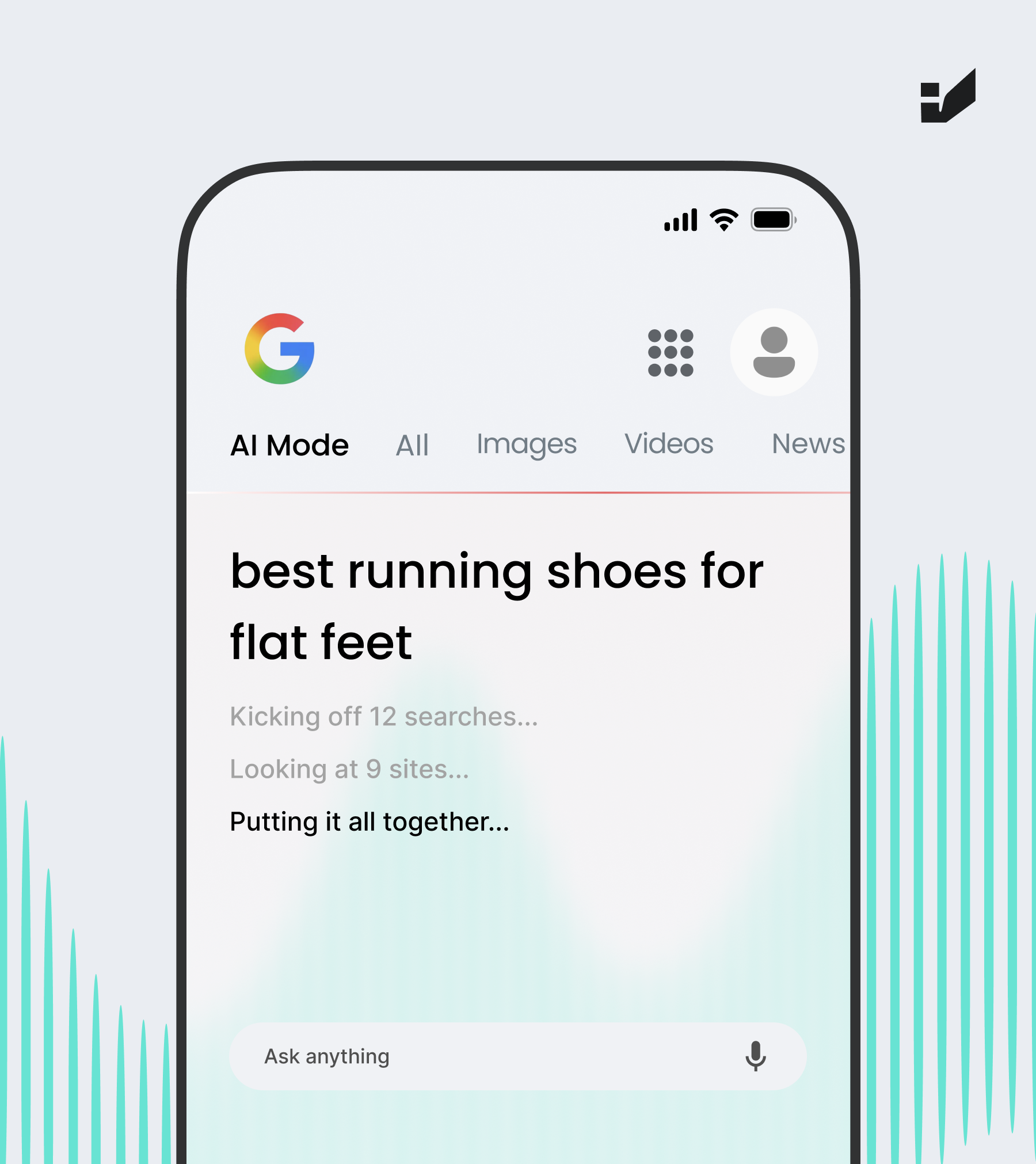
and receives product recommendations with links to stores cited by AI.
Key trends and insights
- Rise of zero-click searches: Users increasingly get answers directly on the search page, reducing organic traffic to websites.
- Shift in SEO models: Traditional keyword-ranking strategies are losing ground to AI-focused optimization – namely, generative engine optimization (GEO) and answer engine optimization (AEO).
- Emphasis on content quality and structure: AI algorithms prefer comprehensive, well-structured, fact-based content that’s easy to process and summarize.
- Brand authority and reputation matter more: AI tends to cite trusted, authoritative sources – requiring brands to invest in reputation-building and quality backlinks.
- Integration with visual and voice search: AI Mode increasingly uses images and voice, pushing marketers to optimize content for these formats as well.

Recommendations for marketers and SEOs
- Prioritize high-quality, comprehensive content
Create in-depth, fact-based content that addresses a broad range of related queries. AI favors complete and trustworthy answers.
- Structure content clearly
Use clear headings (H1–H6), bullet points, lists, and tables. This helps AI extract and highlight key information.
- Answer user questions directly
Develop content that directly addresses specific user questions, especially through FAQ articles or how-to guides in a conversational tone.
- Use multimedia elements
Incorporate videos, infographics, and other formats that attract attention and are easy for AI to interpret.
- Optimize for visual and voice search
Ensure your content is accessible via image and voice search, particularly for younger audiences like Gen Z.
- Build brand authority
Invest in your brand’s reputation, acquire high-quality backlinks, and ensure factual accuracy. Being cited in AI Overviews boosts credibility.
- Monitor and analyze SERPs
Regularly check search results for key phrases to understand when and how AI Overviews appear and which sources are being cited.
- Experiment with new formats
Try creating infographics, videos, interactive quizzes, and other engaging formats that appeal to users and AI alike.
- Integrate with Google Shopping
For e-commerce, optimize product listings in Google Merchant Center using detailed structured data.
10. Track mentions in AI Overviews
Treat mentions in AI answers as brand visibility and trust-building opportunities, even if they don’t lead to direct clicks.
Expert insight
At Google Search Central Live 2025 in Warsaw, Martin Splitt stated:
“So, yes, if things are being shown in AI overviews, you will probably see less clicks.”
Then he added:
“(…) So likely your impressions are going to go up if you are shown in AI overviews or AI mode. Um clicks are likely to stagnate or fall a little bit. (…) But likely this might increase your conversions, which is pretty good, I think.”
This quote reflects the current industry shift: AI Overviews and AI Mode in the U.S. are drastically changing organic traffic dynamics, creating what some call the “great decoupling” – a growing gap between impressions and clicks. This is directly tied to Google serving AI-generated answers right on the search page.
At the same time, as Splitt points out, the clicks that still come through are more valuable and often lead to conversions – though some interactions now happen outside the traditional search path.
In practice, this means brands need to prepare for a new reality where their role in users’ decision-making is limited to the discovery phase, while their influence on later stages of the marketing funnel becomes harder to predict. This presents challenges for SEO and content strategies, which must now focus more on building authority and trust to be chosen by AI as a reliable source – even if that doesn’t result in a direct click.
Conclusion
AI Mode and AI Overviews represent a fundamental shift in the U.S. search landscape. Brands that want to remain visible and trustworthy must adapt their SEO and marketing strategies to meet AI algorithm demands and user expectations.
The key lies in creating high-quality content, optimizing for new search formats, and constantly tracking market changes. In the age of AI, being cited in AI-generated answers may become just as important as ranking high in traditional search results.
Get free AI Search Visibility checklist
How’s your brand’s visibility in AI Search? Assess & optimize it with an actionable checklist.



